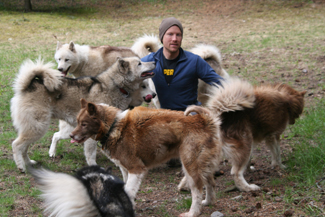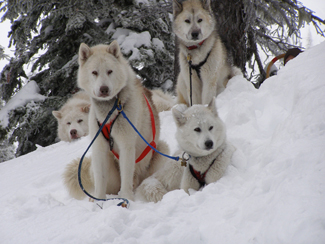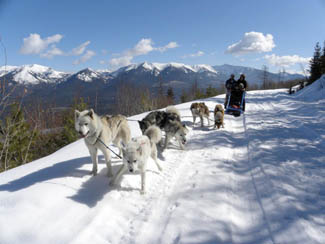From the Editor: Romancing the Bone –
Unreasonable notions and unrealistic expectations
Kevin Walton Memorial Lecture
QTC’s Community Consultation Tour
An Examination of Traditional Knowledge:
The Case of the Inuit Sled Dog, Part 3
'The Hunt'
OP Nunalivut 10
CAAT Returns to Baker Lake
New to the Crew: Introducing Adult ISDs to Your Kennel
IMHO: Some Things Never Change
Navigating This Site
Index of articles by subject
Index of back issues by volume number
Search The Fan Hitch
Articles to download and print
Ordering Ken MacRury's Thesis
Our comprehensive list of resources
Talk to The Fan Hitch
The Fan Hitch home page
ISDI home page
Editor-in-Chief: Sue Hamilton
Webmaster: Mark Hamilton
Print Edition: Imaged and distributed by the IPL students of the Ulluriaq School, Kangiqsualujjuaq, Nunavik
The Fan Hitch,
Journal of the Inuit Sled Dog International,
is published four times a year. It is
available at no cost online at:
https://thefanhitch.org.
Print subscriptions: in Canada $20.00, in USA $23.00, elsewhere $32.00 per year, postage included. All prices are in Canadian dollars. Make checks payable in Canadian dollars only to "Mark Brazeau", and send to Mark Brazeau, Box 151 Kangiqsualujjuaq QC J0M 1N0 Canada. (Back issues are also available. Contact Sue Hamilton.)
The Fan Hitch welcomes your letters, stories, comments and suggestions. The editorial staff reserves the right to edit submissions used for publication.
Contents of The Fan Hitch are protected by international copyright laws. No photo, drawing or text may be reproduced in any form without written consent. Webmasters please note: written consent is necessary before linking this site to yours! Please forward requests to Sue Hamilton, 55 Town Line Rd., Harwinton, Connecticut 06791, USA or mail@thefanhitch.org
Print subscriptions: in Canada $20.00, in USA $23.00, elsewhere $32.00 per year, postage included. All prices are in Canadian dollars. Make checks payable in Canadian dollars only to "Mark Brazeau", and send to Mark Brazeau, Box 151 Kangiqsualujjuaq QC J0M 1N0 Canada. (Back issues are also available. Contact Sue Hamilton.)
The Fan Hitch welcomes your letters, stories, comments and suggestions. The editorial staff reserves the right to edit submissions used for publication.
Contents of The Fan Hitch are protected by international copyright laws. No photo, drawing or text may be reproduced in any form without written consent. Webmasters please note: written consent is necessary before linking this site to yours! Please forward requests to Sue Hamilton, 55 Town Line Rd., Harwinton, Connecticut 06791, USA or mail@thefanhitch.org
The Inuit Sled Dog International
The Inuit Sled Dog International (ISDI) is a consortium of enthusiasts whose goal is the preservation of this ancient arctic breed in its purest form as a working dog. The ISDI's efforts are concentrated on restoring the pure Inuit Dog to its native habitat. The ISDI's coordinators welcome to your comments and questions.
ISDI Coordinator Canada:
Geneviève Montcombroux, Box 206, Inwood, MB R0C 1P0; gmontcombroux@gmail.com
ISDI Coordinator USA:
Sue Hamilton, 55 Town Line Road, Harwinton, CT 06791, mail@thefanhitch.org

Mark Schurke surrounded by his Inuit Dogs. The two red dogs are
Whiskers, an alpha female and lead dog and Ginger, a boss dog,
both around eight years-old and both intact. In this photo they
have been with Mark for about three months. Photo: Schurke
New to the Crew
by Mark Schurke
Bigfork, Montana, USA
For many Inuit Dog owners a time may come when they decide to expand their kennel. This can often pose a serious challenge since the breed can be hard to come by due to its rarity. Access to puppies is very limited since Inuit Dog breeders and litters are few and far between. Another, more regularly occurring option for acquiring Inuit Dogs is to adopt a retired working dog or one in need of a new home. Depending on their age and physical ability, retired dogs can still contribute, making a great addition to an already established team or simply just a new companion for outdoor active lovers of the breed. Just as raising a puppy can have its challenges and rewards, introducing an adult dog to your existing "pack" can be the same. The process is always situational and often learned by trial and error. What follows in this article are some recommendations to help make the experience a positive one for both you and your dogs.
Over the past ten years I have worked with many Inuit Dogs, several of which came as adults from other kennels. For me this began in Ely, Minnesota, working for my uncle, Paul Schurke, at Wintergreen Dogsled Lodge. Having spent four years guiding dog sled trips and managing the kennel of seventy Inuit Dogs, I have developed a deep understanding of this dynamic breed. While caring for the dogs in the off season, we were constantly experimenting and evolving our systems to manage the kennel more efficiently while providing the best possible home and care for our dogs. This eventually led to an open pen design where the dogs were able to interact in small "packs" or groups of about four to six per pen. In all aspects, this made for more enjoyable kennel life for the dogs and for us to manage. However, a dog's life in this type of arrangement is much like life in a television soap opera: there is day-to-day drama. We have to be much more mindful of individual dog personalities as well as how they interact one-on-one, in a pack, and with friend(s) or foe(s). This is especially true when introducing a new dog.
Whenever possible, Wintergreen always tries to provide a home for adult Inuit Dogs in need of a new one. Throughout the years Wintergreen has also been a means for connecting people searching for dogs with those needing to relocate them. This is how I acquired my first eight dogs two-and-a-half years ago. I have since expanded my kennel to twelve and have started my own dog sledding adventure business, Base Camp Bigfork, located in Bigfork, Montana. Very much like Wintergreen, we specialize in hands-on dog sledding trips for all ability levels where participants get to mush their own team of Inuit Dogs. As I have gone from one dog to twelve in the last two years, the process of introducing a new dog is fresh in my mind and continues on a daily basis.
When introducing a new dog many factors can influence the outcome. Everyone's situation will be unique and is really all based upon the personalities of the dogs and your ability as their owner to understand them as well as your ability to command their respect. Having recently acquired new dogs from the full spectrum of age and personalities, I have dealt with many situations that others may encounter. All but one of my dogs has come to me as an adult. My kennel consists of a family pack of four six-year-olds, one single who is two-years-old; and three sets of two ranging from seven to fourteen years of age, plus our family dog, a six-year-old Shepherd/Husky.
There are few things to consider before introducing a new dog. Getting to know the new arrival and how he or she associates with other dogs is vital when adding to the mix. The level of dominance of your new and existing dogs and the ability for your dogs to figure out pack structure and hierarchy will play a part in the process as well. The sex of your dogs will also influence the situation and if a bitch is in heat. Make sure you have established some level of a trusting relationship between you and the newcomer before introducing it to the others.

Photo: Schurke
Depending on your kennel size, you should introduce your new dog to the others a few at a time in a large, open pen or yard area. I have found that a new dog seems to know it is on new turf and tends to size up the area and situation before trying to establish its dominance or place in the pack. Avoid areas and situations where dogs feel congested, such as when opening pen gates or when they group together. Begin with your less dominant dogs or those whose personalities are easier going. The new dog will most likely run around sniffing out and marking the area while making brief interactions with the original dogs in passing. Always be on point and watch for clues indicating how things are going. Physical cues the dogs may give are the standard rising of the guard hairs, position of the tail - up/down/or wagging, play behavior, nervous whimpering, growling, showing of teeth and the inevitable fight. The more in tune you are with the energy taking place, the better you will be able to foresee any problems that may arise and determine who may be compatible with whom. First impressions apply to dogs as well and you really want this first encounter to be a positive one.
Fighting is as much a part of the Inuit Dog’s character as is its desire to pull. In most cases it is just the breed's hardheaded way of communicating and establishing dominance and social order. It has been part of Inuit Dog evolution and they are built for it. Most fights result in minor injuries if any at all, although things can sometimes get ugly especially when more than two dogs are involved. Dogs who are litter mates often times work together, acting as one pack when a fight breaks out leaving the dog being attacked very vulnerable. Even Ken MacRury in his thesis The Inuit Dog: It's Provenance, Environment and History, mentions that the Inuit people would rarely keep more than two or three littermates in their teams because of their potential to act as one mind. I have experienced this with my dogs and it can be a very challenging fight to break up and may often result in more significant injuries. Some fighting should be expected and, depending on the situation, I will let the dogs work things out for themselves. However, as my dogs are exposed to new people on a regular basis and I don't care for injured dogs and vet bills, I typically nip fights in the bud. Since introducing a new dog will most likely amount to some level of fighting, the owner must be comfortable with a few brawls and be physically able to break one up when it exceeds an acceptable level.
As your dog settles into its new home, you will also want to consider daily situations such as feeding, where it will spend time, and how you will work/run him or her with the rest of the team. For me, being able to keep my dogs in pens has been an ideal situation. It gives me the ability to rotate dogs to new areas and to keep certain dogs together or separate. When the dogs are unattended I keep them with others with whom I know they will get along and feel safe. They are typically in groups of about two to five. I will allow my dogs to intermingle only when doing kennel chores, working outside, playing with them or just enjoying watching them interact.
Feeding in an open pen system can be challenging. When possible feed your dogs separately to avoid fights and to allow each dog a chance to consume its food rather than inhale it. New dogs may not eat when fed until it becomes routine for them. They typically will become protective over uneaten food, so make sure you remove any leftovers before you allow the dogs to commingle again where food had been offered.
When it comes time to run your new dog with a team, start by running him or her either along side a submissive dog or alone on the gangline. I usually start new dogs in the wheel position until I see how well they run with the others. This allows the dog to feel more comfortable since there is no threat from behind. Be mindful of running too many littermates or a very close knit team with your new dog. If a fight were to break out, it will most likely result in an all-on-one situation. For me, new adult dogs have added to my ability to be more flexible with how I run my teams by giving me more compatible pairs.
A new dog will always be a new dog, much like a person who has relocated to a new place may never be considered a local. Dogs feels the stress similar to what humans feel when moving although, we (hopefully) exhibit our reactions much differently than they do. Introducing a new dog can be a challenging process that continues throughout the life of your dogs. For every dog and owner will come new and different situations. With these challenges comes knowledge that ultimately leads to a better understanding of this breed and contributes to the rewards of working with them.
Take your time and err on the side of caution when bringing a new dog into the mix in all areas of their life.
If you would like to contact me to talk dogs or learn more about Base Camp Bigfork sledding adventures with Inuit Dogs, please visit basecampbigfork.com.

Photo: Schurke